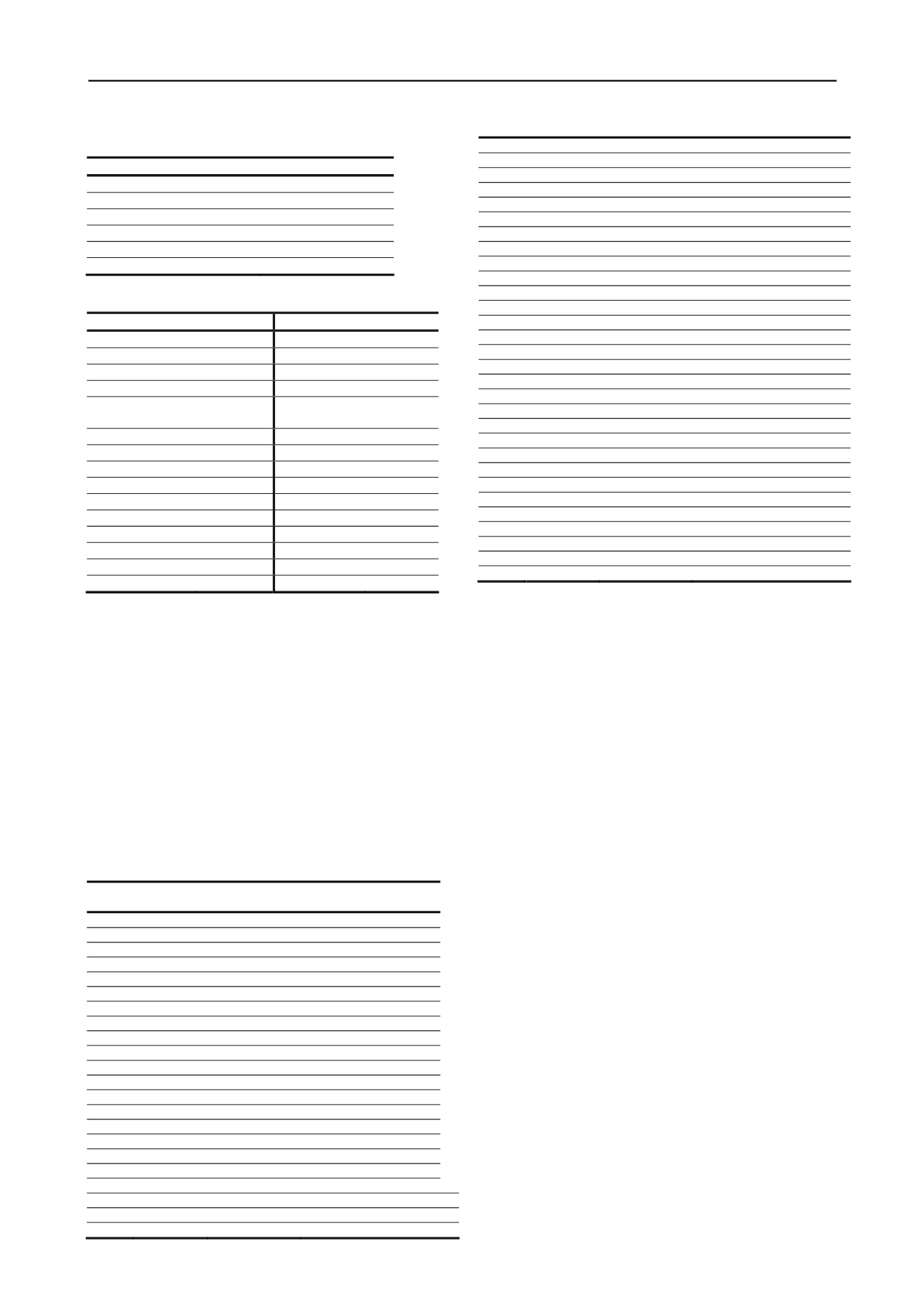
648
Proceedings of the 18
th
International Conference on Soil Mechanics and Geotechnical Engineering, Paris 2013
Table 1. Paper distributions among continents
Continent
Paper No.
Africa
1
Asia
15
Australia
4
Europe
23
North America
8
South America
1
Table 2. Geographical distribution of 52 papers
Country
Paper No. Country
Paper No.
Australia
4
Ireland
1
Bangladesh
1
Japan
4
Brazil
1
Mexico
1
Canada
5
Netherlands
2
China,
Mainland
1
Norway
4
China, Taiwan
1
Protugal
1
Croatia
1
Russia
2
Denmark
1
Singapore
2
Egypt
1
South Korea
1
Finland
1
Spain
3
France
2
Switzerland
1
Germany
1
Thailand
1
India
1
UK
3
Indonesia
1
USA
2
Iran
2
2 CLASSIFICATION OF PAPERS UNDER DIFFERENT
ASPECTS
To help readers to search for information from this Session on
Numerical Methods, different aspects of these papers are
grouped in a tabular form under different aspects. More
specifically, a brief summary of all 52 papers is given in Table 3.
The first column compiles the the types of numerical methods
empolyed by various authors, second cloumn summarizes the
software used if any, and the third column provides the types of
problems that these numerical methods were proposed for.
The paper number actually follows the appearing order of
these papers in the reference section. For example, P1 is
Balkumar et al. (2013) whereas P52 is Yoneda (2013), etc.
Table 3. Classification of 52 papers into different aspects.
Paper
No.
Method Software used
Applications
P1
FEM
Plaxis
Pile
P2
FDM
FLAC
Reinforced earth
P3
-
-
Constitutive modeling
P4
-
-
Constitutive modeling
P5
FDM
FLAC
Soil-pile interaction
P6
FEM
-
Validation of FEM
P7
FDM
FLAC
Stone column
P8
SPH
-
Retaining wall
P9
FEM
Plaxis
Seismic pile
P10
FEM
GeoFEA
Large scale analysis on PC
P11
FEM
Plaxis
Hardening soil model
P12
FEM
-
Strain localization
P13
FEM
ABAQUS
Pile movement
P14
FEM
Plaxis
Excavation
P15
FVM
Riemann solver Levee erosion
P16
FEM
ABAQUS
Pile driving
P17
FEM
-
Soil modeling
P18
FEM
CORONA
Earth structures
P19
RFEM
RFLA
Undrained bearing capacity
P20
-
-
Tailings
P21
FEM/FDM GA
Coastal aquifers
P22
SPH
-
Levee erosion
P23
Galerkin
-
Soil-structure interaction
P24
FDM
FLAC
Soil-pile-structure interaction
P25
LEM
MUESA
Pore pressure
P26
FEM
SVSLOPE-3D
slope
P27
FEM
ABAQUS
Bridge/ Soil-structure
P28
FDM
FLAC
Tunnel
P29
FEM
-
Retaining wall
P30
FDM
FLAC/GA
Constitutive law for soft rock
P31
Analytic
-
penetrators
P32
-
-
Embankments/ Chemical-soil
P33
FEM
ABAQUS
Tunnel
P34
FEM
ABAQUS
Retaining wall
P35
NN
-
Pile-settlement
P36
FEM
-
Cyclic model/ constitutive
P37
FEM
FREW
Tunnel
P38
FEM
-
Breakwaters
P39
FDM
FLAC-2D
Desication crack
P40
FEM
-
Pile
P41
FEM
Iwan model
Deep excavation
P42
FEM
Plaxis-3D
Pile/tunnel
P43
-
-
Backfill
P44
FEM
-
Soil-structure interaction
P45
FDM
FLAC
Liquefaction
P46
NN
-
Single pile
P47
FEM
GEOASLA
Soil-water
P48
-
-
Constitutive modeling
P49
FEM
ABAQUS
Embankment
P50
MPM
-
Slope
P51
FEM
-
Pore water pressure
P52
FEM
COTHMA
Methane hydrate
Note that the following abbreviations are used: FEM = Finite
Element Method, FDM = Finite Difference Method, FVM =
Finite Volume Method, SPH = Smoothed Particle
Hydrodynamics, MPM = Material Point Method, RFEM =
Random Finite Element Method, GA = Genetic Algorithm, NN
= Neural Network, and LEM = Limit equilibrium. Table 3 also
provides a quick reference guide to all 52 papers, depending on
the interest of the readers.
2.1
Numerical methods used
2.1.1
Finite difference method
The origin of finite difference method (FDM) probably traces
back to the time of Leibniz and Euler (e.g. Euler’s method in
1768), and subsequently evolves into different techniques (e.g.
Runge-Kutta method). The FDM becomes more established
since 1928 after the Courant-Friedrichs-Lewy (CFL) stability
condition was derived for hyperbolic type of partial differential
equations (Courant et al. 1928). Its day-to-day application, of
course, starts with the popularization of computers, especially
personal computers. For the use of finite difference method,
there are 8 papers empolyed FDM and the sofware used is
called FLAC (either 2D or 3D). They include Bennani et al.
(2013), Breugnot et al. (2013), Bryson and El Naggar (2013),
Kwon et al. (2013), Mayoral et al. (2013), Pereira et al. (2013),
Stirling et al. (2013), and Wanatowski et al. (2013). The full
name of FLAC is Fast Lagrangian Analysis of Continua, and it
is a continuum code for modelling soil, rock and structural
behaviour. It employs the explicit finite difference formulation
and suites for modelling multistage geomechanical problems,
such as sequential excavation, backfilling and loading. The
formulation can accommodate large displacements and strains
and non-linear material behaviour, even if yield or failure
occurs over a large area or if total collapse occurs.
2.1.2
Finite element method
Finite element method (FEM) is a numerical technique for
finding approximate solutions to boundary value problems. It
uses either the weighted residue method (e.g. Galerkin method)
or the variational methods via the use of calculus of variations
(e.g. Rayleigh-Ritz method) to minimize an error function (in
the case of weighted residue approach) or a functional (energy


